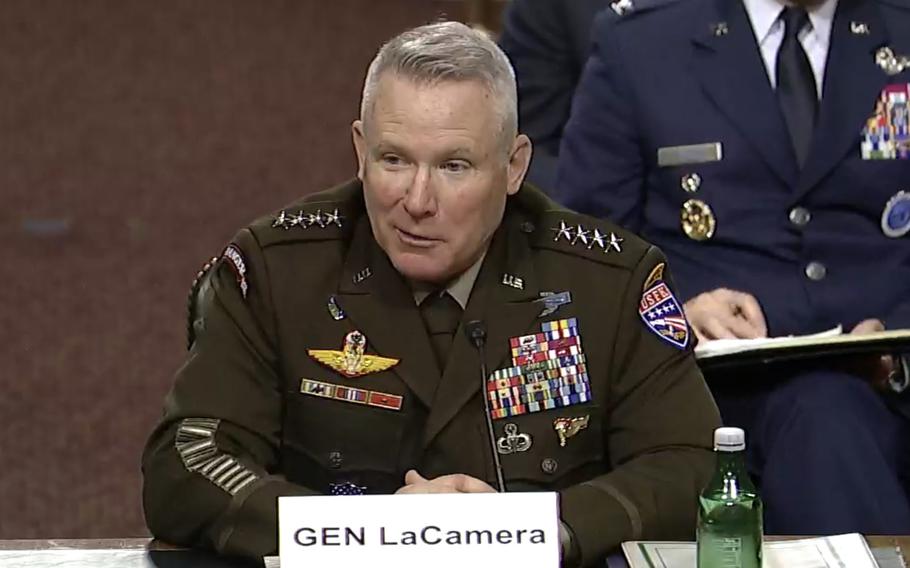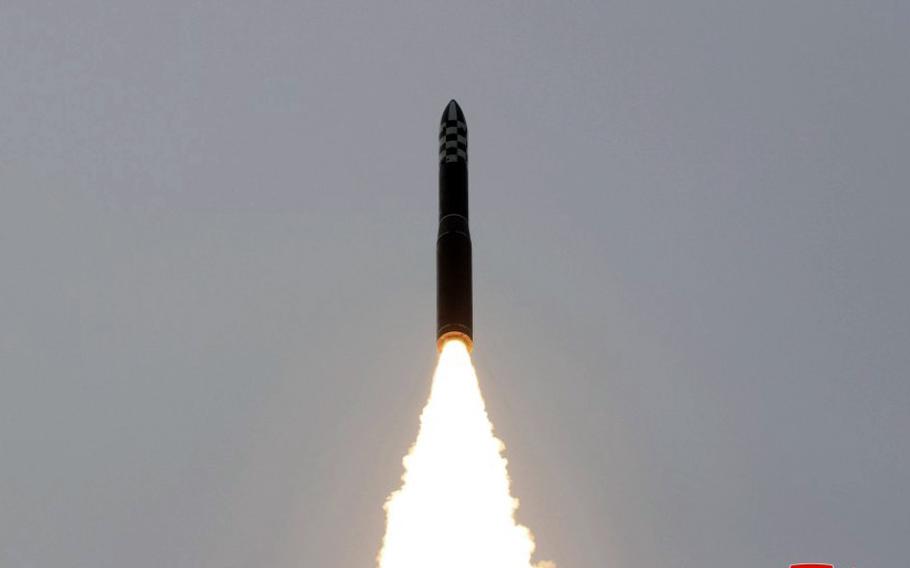
U.S. Forces Korea commander Gen. Paul LaCamera testifies during a Senate Armed Services Committee hearing in Washington, D.C., April 20, 2023. (U.S. Senate)
North Korea’s recent ballistic missile tests are part of a two-year-old military blueprint and a reaction to U.S. and South Korea military exercises, the commander of U.S. Forces Korea told a congressional panel Thursday.
North Korean leader Kim Jong Un “laid out a trajectory” and “he is moving on it,” Gen. Paul LaCamera said in testimony before the Senate Armed Services Committee in Washington, D.C.
Kim unveiled a plan during North Korea’s ruling Workers’ Party Congress in 2021 that included development of strategic nuclear weapons and a nuclear-powered submarine.
“We must further strengthen the nuclear war deterrent while doing our best to build up the most powerful military strength,” Kim said at the time, according to the Korean Central News Agency.
North Korea has fired 12 ballistic missiles in nine separate days of testing so far this year. The communist regime last fired what it claimed was a solid-fuel intercontinental ballistic missile on April 12.
South Korea’s military estimated that the missile, launched near Pyongyang, flew 620 miles and splashed into the East Sea, or Sea of Japan. The launch prompted the Japanese government to warn residents in Hokkaido to seek shelter and halt trains for roughly 25 minutes.
Kim is also reacting to the largest-ever military drills by Washington and Seoul, conducted last month throughout South Korea and in the air and waters that surround it, LaCamera told the committee. North Korea continued to fire missiles while the exercises were underway.

North Korea launched a solid fueled Hwasong-18 intercontinental ballistic missile, April 13, 2023, according to the state-run Korean Central News Agency. (KCNA)
“The challenge is when we telegraph the timing of it — it gives [Kim] an opportunity to plan to use that as a reaction to us,” he added. USFK regularly declines to publicize details of its military drills due to security concerns.
During the Warrior Shield exercise, around 1,200 U.S. and South Korean soldiers conducted a four-day field exercise at six separate sites that included live-fire by artillery and tanks, mine removal, aerial assaults and squad-level infantry maneuvers.
Naval and amphibious forces carried out the two-week Ssangyong exercise with the arrival of the aircraft carrier USS Nimitz and its strike group in Busan. U.S. sailors and Marines equipped with Marine Corps V-22 Osprey tiltrotor aircraft and amphibious assault vehicles conducted sea and landing operations with their South Korean counterparts on the peninsula’s southern coast.
In addition, U.S. troops held the Freedom Shield exercise that for the first time tested the Terminal High Altitude Area Defense anti-missile system’s remote launcher capability in an operational setting on March 24. The remote launcher function allows the Army’s THAAD system to fire missile interceptors remotely and increases the user’s defensive range.
North Korea’s missile launches also prompted air power demonstrations over and around the Korean Peninsula. On April 14, one day after Pyongyang last fired a ballistic missile, at least two Air Force B-52H Stratofortress bombers and four F-16 Fighting Falcons flew alongside four South Korean air force F-35As over South Korean airspace, according to a press release and photos of the flight from U.S. Indo-Pacific Command.
The U.S. and South Korean military describe their drills as defensive in nature, but North Korea’s official propaganda arm calls them a “declaration of war” and rehearsal for an invasion.
Security around the region is “unstable” due to “the reckless and provocative military maneuvers of the U.S. and its allies,” North Korean Foreign Affairs Minister Choe Son Hui said in a statement in KCNA on Friday.
“The U.S. and the West have no right to say this or that about [North Korea’s] position as a nuclear weapons state, and it will never change no matter what they say,” he said.